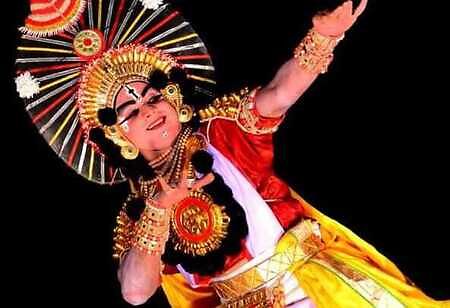
The Dark Story of a Colored Life


Many of us are fortunate to have childhoods full of happiness and bundles of refreshing memories. A big part of it can be attributed to having our cousins as best friends—our little partners in crime. I, for one, always used to wait for weekends or holidays to meet my cousins. As a Kannadiga from the Southern part of the state, the wait was not only to play games with them but also to attend a Yakshagana program organized in the central area of the town. The Yakshagana happens at night, making the high voltage theme song of Bhagavatha inviting the villain in the play look terrific. The moment Yaksha (nature spirit) enters the stage by pulling the screen is mesmerizing—a memory that always pulls you closer to your roots. Fights between Kings and Villains in the story, while appealing to the deepest of our feelings and emotions, also give moral messages to society. Sometimes the next day's dream will be about the villain who scared us. But, yes, we got to know many mythological stories through Yakshagana.
All about Yakshagana
Yakshagana is one of the most popular folk theater forms in Southern Karnataka, as well as Kasaragod, the adjacent border district of Kerala. It is composed of music, colorful costumes, vigorous dance movements, subtle expressions and extempore dialogues. Yakshsna has variations—Moodalapaya (the eastern form popular in north Karnataka) and Paduvalapaya (a Western-style also known as coastal Yakshagana), each of which has many sub-variations. Let's go towards the south from Dakshina Kannada to Kasaragod of the Tulu Nadu region. The form of Yakshagana is called Thenku Thittu, and towards the north, from Udupi up to Uttara Kannada, it is called Badaga Thittu. The coastal Yakshagana is more popular for the great sophistication that it has achieved over the years through the efforts of artists, thinkers and researchers. It is more exuberant and refined when compared to all the other styles.
Elements of Yakshagana
The Act: Each performance typically focuses on a small sub-story called Prasanga from ancient Hindu epics of Ramayana or Mahabharata. The show consists of both stage performances by talented artists and commentary imbued in traditional music.
The Music: Musical instruments such as Chande (drums), Harmonium, Maddale, Taala (mini metal clappers) and flute, among others, are used in Yakshagana.
The Attire: Costumes used in Yakshagana are unique and elaborate. Large-size headgear, colored faces, elaborate costumes all over the body and musical beads on the legs (Gejje) are all part of the costume. Performers need a great physique to perform with heavy costumes for several hours and also strong voice and acting/dancing skills.
Prasanga and Literature
Yakshagana poetry, or Yakshagana Prasanga, is a collection of poems written to form a musical drama. The lyrics are composed using a framework of ragas and talas. Yakshagana has its own wavelength. The collection of Yakshagana poems forming a musical drama is called a Prasanga. It is believed that the oldest surviving Parasanga books were composed in the 15th century. But many compositions have been lost to time. Evidence shows that oral compositions were in use before the 15th century.
The Troupes: Several popular troupes (known as Melas) perform Yakshagana throughout the year. Saligrama Mela, Dharmasthala Mela, Mandarthi Mela, and Perduru Mela are some of the leading names.
Life of Yakshagana Artists
From well-educated to uneducated people, people from all walks of life perform Yakshagana. There is no caste or religious barrier to performing this art form. Yakshagana employs a lot of people from coastal areas. People are paid well according to their performance.
However, the Yakshagana artists have their own struggles in their lives.
For instance, most of the Yakshagana themes are taken from the Ramayana and Mahabharata epics, which is quite challenging for the artists as they need a deep bass voice. People who have an inherent bass voice can then play the role accordingly.
But for others, that won't be easy. The major issue is that artists and singers must go to rehearsal every day and play different acts. And the programs will not be in the same place as well. They have to travel to different places according to their team's suggestions. They will be paid on a daily basis.
COVID-19, which hit all the industries, didn't spare the Yakshagana either. The pandemic turned the lives of Yakshagana artists upside down. People who depended entirely on the Yakshagana for income suffered severely without a proper job. The government had put restrictions on the Yakshagana teams as gathering people spread the infections.
Yakshagana Creating Employment
A 65-year-old artist, Shri Gopal Acharya, is among the great artists of Yakshagana who has been given the honorary name ‘Vedikeya Abhimanyu.’ He studied only till the third standard. As he belonged to a lower-middle family, his father couldn’t afford him an education. To lead life, he had to do some job. He joined a Yakshagana group, learned Yakshagana from one of the senior artists, and started performing in stages in childhood. Starting the day's salary used to be only 30 to 40 rupees. Life used to be hard for him and his family. As the programs used to be in different cities, he had to travel by bus for the program.
As time changed, the artists' lives also started to change. The salary has increased from 50 rs to 5000, and he doesn’t have to perform in everyday programs. Through the income he is earning, he can give a better education to his children. For his performance in Yakshagana, the Karnataka government has honored him with the Kannada Rajyotsava award.
Now the theme of the Yakshagana is changing. Besides the mythological stories, they also play social stories, which can impact society.